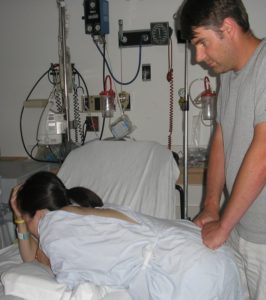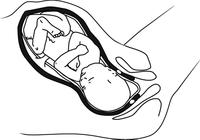There are three stages to the labour and birth process. In the First Stage of labour, your cervix thins and opens so that the baby can then move through the birth canal (vagina). Second Stage is the pushing stage, and ends with the birth of your baby. The Third Stage is the delivery of the placenta.
Labour often lasts 10 to 14 hours for first time parents. However this is just an average. In reality, labours can vary from a few hours to 36 hours or more. Subsequent labours are usually shorter. The length of time you spend in labour depends on many factors including:
- The position of your baby
- The strength and pattern of your contractions
- Your own health
- Whether or not it is your first baby
- Your mental preparations for birth
- The positions you are in during labour
- The hormones typically present during labour and birth
- Take Note: OXYTOCIN is the hormone that makes your body produce contractions. Staying calm, focused and using comfort strategies can help your body maintain your level of oxytocin and will help labour progress.
Labour pain
There is no such thing as a “pain-free labour”. However, pain in labour is not the same as other types of pain, which signal illness or danger. Labour pain is:
Productive: Each contraction works towards the birth of the baby
Anticipated: We know that labour contractions will hurt, and that after each contraction there will be a break
Intermittent: Labour pain is not constant. There are breaks between the contractions. In the early part of labour, the breaks are longer then the contractions
Normal: Labour pain is a sign that the body is healthy and working to birth the baby
Each women’s belief about pain, pain tolerance, pain threshold and life experiences will affect how she experiences labour pain.
The pain in the first stage of labour is a result of the uterine muscles contracting and pulling, the cervix stretching, pressure on ligaments, and pressure on the pelvis as the baby moves down to come closer to birth.
During the pushing stage, the pain comes from stretching of the vagina, and pressure on the pelvis, rectum and bladder.

TAKE NOTE: Throughout labour, the pain can also be affected by the position of the baby.
In section 104 you will learn ways to reduce labour pain and be more comfortable. There are many tools to cope with labour pain, and each person will find what works best for them. It’s important for both the labouring person and support person to remember that pain is a normal part of labour, and that coping with pain is different than suffering from pain.

Contractions
Contractions are the rhythmic tightening and relaxing of the muscle of the uterus. In the first stage of labour, these contractions are working to efface (thin) and dilate (open) the cervix so that your baby can pass through the vagina, or birth canal. With first labours, contractions usually start gradually and can be irregular in pattern. Contractions become stronger, longer and closer together as labour progresses. It’s important for both the labouring person and support person to remember that these strong contractions mean the uterine muscle is working hard to dilate the cervix, and that each one brings a parent closer to the birth of their baby.
Everyone feels labour contractions differently. Some compare contractions at the beginning of labour to menstrual cramps or a feeling of pressure in their pelvis or thighs. As labour becomes stronger, many feel discomfort across the abdomen and possibly even around the back.
Timing contractions
To figure out how far apart your contractions are, your support person can time contractions from the beginning of one, to the beginning of the next. To determine the length of the contraction, they also note how long it lasts. If you contact your healthcare provider or go to the hospital you will be asked how far apart your contractions are, and approximately how long they are lasting. For example 5 minutes apart from the beginning of one to the beginning of the next and lasting a minute.